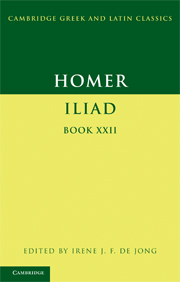Preface
Published online by Cambridge University Press: 05 June 2012
Summary
Some thirty years ago I applied for a grant to write a thesis that would consist of a commentary on Iliad 22. I was not awarded the grant and when a rumour started to spread that a team under the supervision of Geoffrey Kirk was preparing a commentary on the whole Iliad I turned my attention to another topic, the application of narratology to Homer. Given this history, it was with great joy that I accepted the invitation of the series editors Pat Easterling and Richard Hunter to write a ‘Green and Yellow’ on this very book.
I have focused on two aspects in this commentary: Homer’s language (especially his oral syntax, the meaning of words, and the function of particles) and narrative style (for instance the structure of scenes, the relationship of narrator and characters, and the directing of the narratees’ emotional response). Much important work has been done in the field of the language of the Homeric epics in the last decades. Thus, the invaluable Lexikon des frühgriechischen Epos was finally completed in 2010, and this treasure-trove of information deserves to be introduced more fully into English-speaking Homeric scholarship. I feel a special attachment to this formidable instrument because I spent a very pleasant and formative year as stipendiary in Hamburg, working on lemmata like θέλγω and ἰσόθɛος. Our understanding of Greek particles has advanced greatly since the publication of Denniston’s standard text, not least, if some chauvinism is allowed, thanks to the work of Dutch scholars on τɛ, πɛρ, μήν, δή, and ἄρα. Finally, the insight has dawned that we should approach the oral syntax of Homer somewhat differently from that of later, written texts. It is a flow through time rather than a structure on the space of a page, and keeping this principle in mind can help us to appreciate and better understand the construction of his sentences.
- Type
- Chapter
- Information
- Homer: Iliad Book 22 , pp. vii - viiiPublisher: Cambridge University PressPrint publication year: 2012



